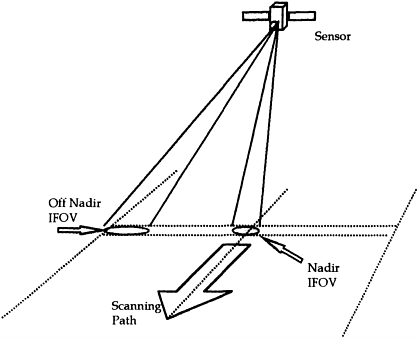3.
| [Cover] [Contents] [Index] |
Page 10

Figure 1.6 The variation in the size of the instantaneous field of view (IFOV) of a sensor across a scan line.
better. However, in practice, this may not always be the case. The choice of spatial resolution should depend on what we want to see. For instance, in everyday life, we recognise a human face from the combination of features such as eyes, nose, lips, etc. Therefore, the appropriate spatial resolution should be set at a level to allow us to recognise each feature in the context of the whole face. It is arguable whether an increase in the spatial resolution of our eyes is likely to improve our identification of faces, once a certain limit has been reached. Thus, the choice of spatial resolution is case-dependent.
Reducing the spatial resolution in terms of narrowing the instrument’s IFOV also affects a related issue. The use of a smaller IFOV implies that the quantity of energy received by a detector is less (because the area from which energy is collected is smaller, and the time available for the sensor to detect the upwelling energy is also shorter). It follows that the instrument’s sensitivity to changes in the levels of energy will decrease, and thus the sensor may not be able to distinguish slight energy differences along a scan line. In other words, the radiometric resolution is degraded. A smaller IFOV may thus result in a worse signal-to-noise ratio, which means that the signal is contaminated by more noise as IFOV decreases (assuming that the same radiometric resolution applies). Although such a decrease in signal-to-noise ratio can be compensated for by enlarging the scanning band-
| [Cover] [Contents] [Index] |
EAN: 2147483647
Pages: 354